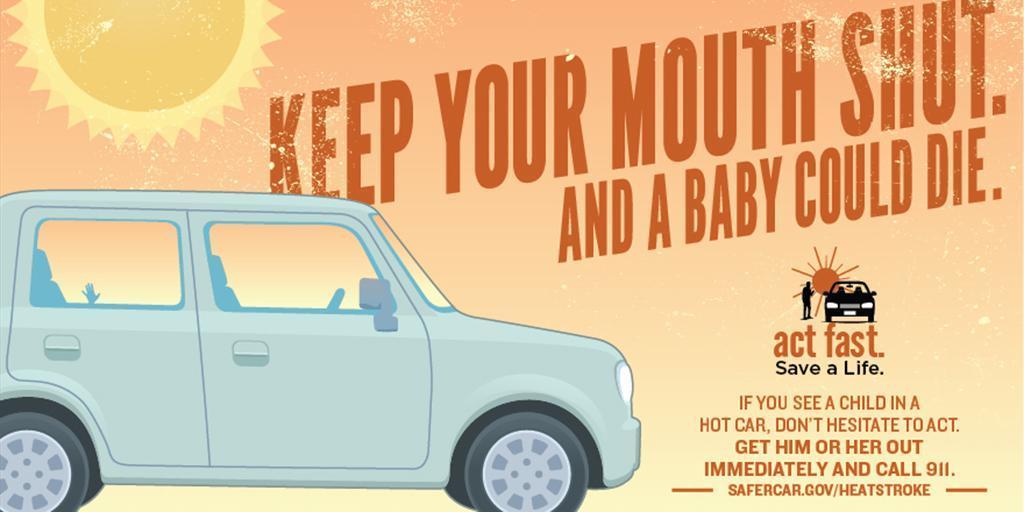
Every summer, you hear the stories about young children who died because their parents left them in a sweltering hot car. And you think, "I would never do that!"
But it's easier than you think to forget your child in the backseat. Heatstroke is the leading cause of non-crash-related fatalities for children 14 and younger, according to the National Highway Traffic Safety Administration. And of the 700 children who died from 1998 to 2016 due to vehicular heatstroke, 54 percent (or 376 children) were forgotten by a caregiver.

It's also easy to say, "But I'm just going inside for 10 minutes!" Well, the temperature in a car can rise by 20 degrees in just 10 minutes. Even on a mild 70-degree day, that would get your car up to a sweltering 90 degrees. On NHTSA's website, you can read the story of Raelyn Balfour, whose 9-month-old son Bryce died after she forgot him in the car on a day that was only in the mid-60s.
NHTSA also offers these tips to help ensure you don't experience a tragedy like Balfour's:
- Always check the back seats of your vehicle before you lock it and walk away.
- Keep a stuffed animal or other memento in your child's car seat when it's empty, and move it to the front seat as a visual reminder when your child is in the back seat.
- If someone else is driving your child, or your daily routine has been altered, always check to make sure your child has arrived safely.
What can passersby do?
If you happen to see a young child left unattended in a car, take action! If the child is not responsive or in distress, call 911 right away and get the child out of the car.
(Recent legislation introduced in the Pennsylvania House of Representatives would provide civil immunity for damage done to a vehicle when forceful entry is necessary to rescue a child.)
If the child is responsive, stay with her until help arrives and have someone else search for the driver.
For more on child passenger safety, visit www.penndot.gov/safety. Join the conversation on social media using the hashtags #checkforbaby and #heatstrokekills. Follow PennDOT on Facebook, Twitter, and Instagram.
ABOUT THIS BLOG
Did you know PennDOT is directly responsible for nearly 40,000 miles of highway and roughly 25,000 bridges? We oversee programs and policies affecting highways, urban and rural public transportation, airports, railroads, ports and waterways, in addition to administering the state's more than 11 million vehicle registrations and 8.8 million driver's licenses.
So, how do we do what we do? And how can we help you travel in Pennsylvania — whether it be for business or leisure — in safe and enjoyable manner? Read PennDOT Way to learn more about the department, what we do, and how and why we do it.
TAGS
50-Year Anniversary, 511PA, Aggressive Driving, Airports, Autonomous Vehicles, Bicycles, Bridges, Child Safety, Community Relations, Construction, COVID-19, Distracted Driving, District 1, District 10, District 11, District 12, District 2, District 3, District 4, District 5, District 6, District 8, District 9, DOTcom, Driver and Vehicle Services, Emergency Responders, Employment, Equity, FAQ Friday, Human Trafficking, Impaired Driving, Innovations, Live Free Ride Alive, Maintenance Monday, Motorcycles, Older Drivers, PA Motorcycle Safety Program, Pedestrians, PennDOT Connects, Ports, Public Transit, Railroads, REAL ID, Road MaP, Roadside Beautification, Rural Roads, Safety, School Buses, Seat Belts, State Transportation Innovation Council (STIC), Sustainability, Teen Drivers, Throwback Thursday, Transportation Funding, Travel in PA, Welcome Centers, Winter, Work Smart, Work Zone, Yellow Dot
LATEST POSTS
PennDOT Continues Sharing, Updating Resources for Local Governments to Pursue Bipartisan Infrastructure Law Funding Opportunities
Norwin High School Wins 2024 ‘Innovations Challenge’
Demo Complete: I-95 CAP Project in Center City Philadelphia
PennDOT Archeologist Connects Past, Present, and Future
Lehigh Valley DUI, Highway Safety Task Force Hosts Law Enforcement Seminar
ARCHIVES
2024
2023
2022
2021
2020
2019
2018
2017

